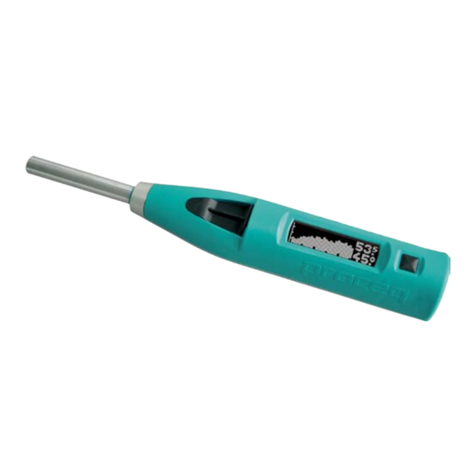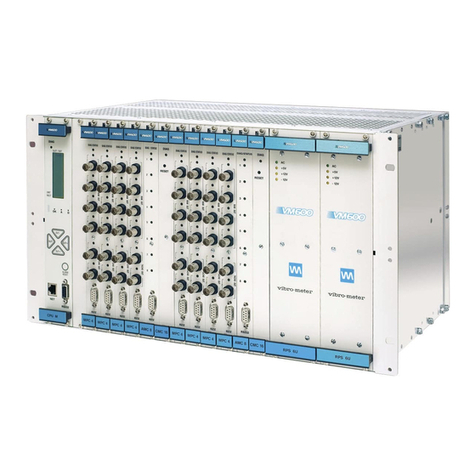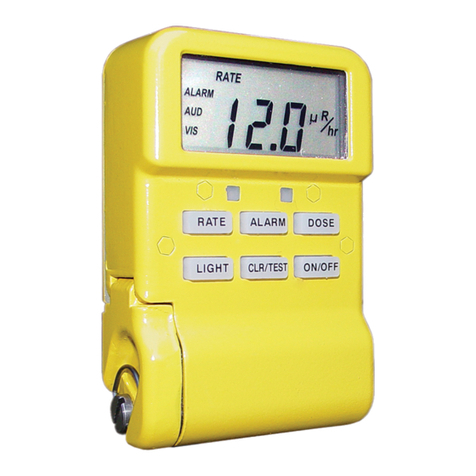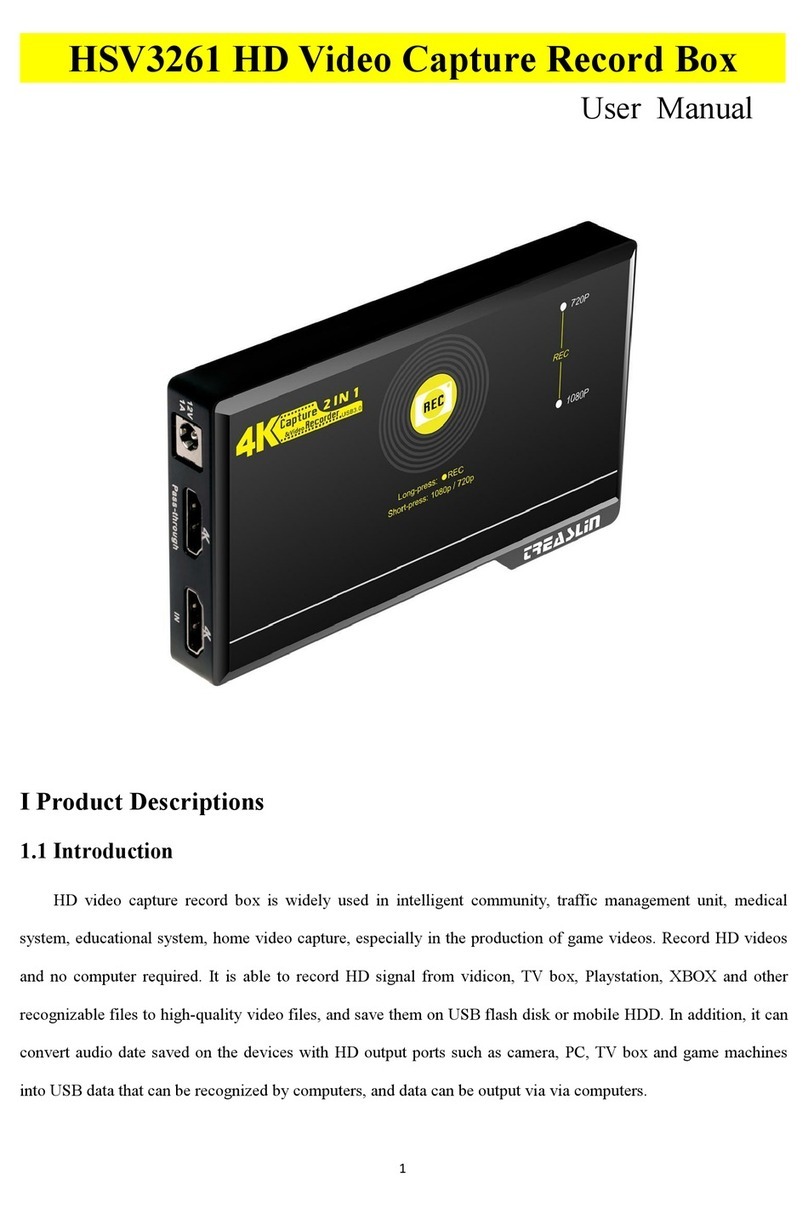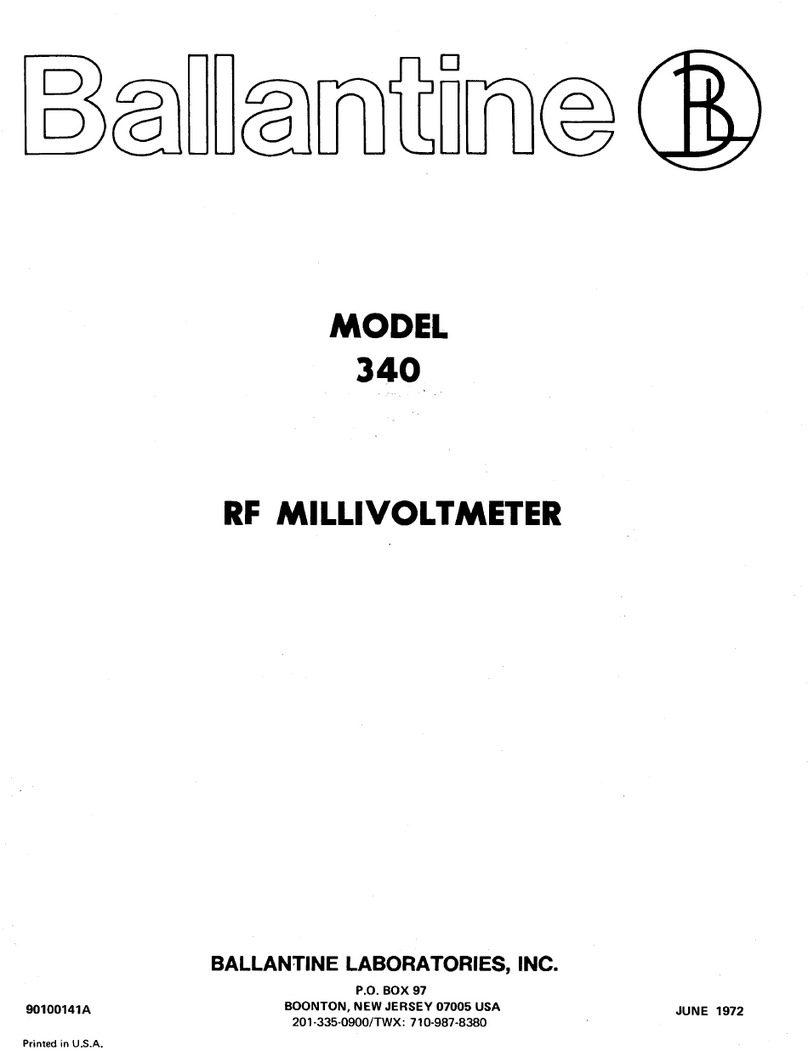RIESE SAFE 4 User manual

ÿ
ÿ
ÿ
ÿ
123453678ÿ9ÿ6ÿ938ÿ5
3ÿ26465ÿ
ÿ11ÿ
1ÿÿÿ1ÿÿ
ÿ
123453678ÿ9ÿ
ÿ
!ÿ 6ÿ938ÿ53ÿ26465ÿ438ÿ
ÿ
" ÿ 1#ÿ$#ÿ%#ÿ&%ÿ
ÿ
! ÿ 'ÿ6428ÿ36ÿ938#ÿÿ6428ÿ()48ÿ793ÿ
ÿÿ
1ÿ6749ÿ4ÿ9(9ÿ6ÿ9(8ÿ5697ÿ
ÿ
1ÿ*" 1" ÿ 93ÿ48ÿ+3,336ÿ7-6639ÿ
ÿ
.-ÿ/1ÿ0ÿ6ÿ,-(ÿ/1ÿ0ÿ94ÿ764ÿ
ÿ
1ÿ ,34#ÿ7-663ÿÿ6ÿ7-663ÿ1ÿ
ÿÿ
1ÿÿÿÿÿ/337467ÿ(930ÿ
ÿ
1" !2ÿ 21ÿ3#ÿ1'3ÿÿÿ/,-ÿ5467ÿ976637646942340ÿ
ÿÿ
ÿ
ÿ
. 1"ÿ !%5 !ÿ
1ÿÿ6ÿ7ÿ7ÿ#ÿ1ÿÿ6ÿ'ÿ.#ÿ31'3ÿÿ6ÿ'#8ÿ
ÿ
ÿ
" ÿ%ÿ19ÿÿ:;ÿ51ÿ
<ÿÿ73ÿ29ÿÿ<ÿÿ'3ÿ29ÿ/1ÿÿÿ<ÿ73290ÿ438ÿ34ÿ23ÿ
38ÿ<ÿ3#7ÿ9ÿ
ÿ
! ÿ9ÿ2)ÿ
7ÿ#ÿ13ÿÿ#ÿ1ÿÿÿÿÿ
ÿ
! ÿ9ÿ26ÿÿ1ÿÿ/=0ÿ >ÿ2ÿ
ÿ
5% !19ÿ ÿ
ÿ1
!" !51! ÿ151" %"1ÿ &17?ÿÿ@ÿ77?ÿ
ÿ
.*!2ÿ9ÿ
133ÿÿ/439943ÿ0ÿ
ÿ
! ÿ1%"9ÿ 6428ÿ36ÿ>#'ÿÿA(7Bÿ765ÿ4ÿ6428ÿ793ÿÿÿ23
ÿ5ÿ
ÿÿ
ÿ
ÿ
ÿ
ÿ
ÿ
1" !2ÿ5 1ÿ
ÿ/
=0ÿ.3ÿ34ÿÿ34739ÿ,-ÿ-43ÿÿ ! ÿÿ
ÿÿÿÿÿÿÿÿÿÿÿÿÿÿÿÿÿ
9ÿÿ26ÿ33ÿ2ÿÿ1ÿÿÿ,-ÿÿ
ÿÿÿÿÿÿÿÿÿÿÿÿÿÿÿÿÿ-
4ÿ5&3ÿ7679ÿ6ÿ-9ÿ,8ÿ-3ÿÿ
ÿÿÿÿÿÿÿÿÿÿÿÿÿÿÿÿÿ
! ÿ9ÿÿ26ÿ33ÿ2ÿ9ÿ68ÿÿ2ÿ
ÿ
393ÿ9Bÿ(4ÿ939ÿ32Cÿ
ÿ
ÿ
ÿ
ÿ
ÿ
ÿ
ÿ
ÿ
ÿ
ÿ
ÿ
ÿ
ÿ
ÿ
ÿ
ÿ
ÿ
!!1 !ÿ2"5ÿ
ÿ9(8ÿ453ÿ2(9ÿ+3ÿ3ÿÿ34269ÿÿ6ÿ
1ÿ,34ÿ1ÿ
(2639ÿ6ÿ1ÿÿÿ9ÿ4+3ÿÿ3426ÿÿ342
69ÿ1ÿ6ÿ
11ÿ2(9ÿ+3ÿ766373ÿ77465ÿÿ-3ÿ76ÿ3)2
3ÿ93373ÿÿ
233ÿ-3ÿ76ÿ43A(432369ÿÿ94ÿ-3ÿ(6ÿ3426
9ÿ''ÿ6ÿ'ÿ
2(9ÿ+3ÿ+453ÿ,-ÿÿ6428ÿ36ÿ767ÿ-3ÿ(6ÿ,
4B9ÿÿ8(ÿ793ÿ
-9ÿ767ÿÿ-9ÿ23ÿ-3ÿ7679ÿ'&#ÿ1'&1ÿ6ÿ''
&'ÿ43ÿ793ÿ
-3ÿ19ÿ7-663ÿÿ6ÿ7-663ÿ1ÿ(263ÿ6ÿ93439ÿÿ
-9ÿ94ÿ+(6ÿ
6ÿ3)346ÿ7674ÿ76ÿ+3ÿ7643ÿÿÿÿÿ
ÿ
4ÿ43496ÿ,-ÿ37-+3ÿ729ÿ/9743,ÿ&ÿ4ÿ753ÿ72
90
ÿÿ
393ÿ9Bÿ(4ÿ939ÿ32Cÿ
ÿ
ÿ
ÿ
'' ' 1
!&*
1&
4
1
11
ÿ
ÿ
ÿ
ÿ
ÿ
ÿ
ÿ
ÿ
%! !ÿ"%ÿ2"5ÿ
ÿ
ÿ
DEFGHEIÿIEKLD
M M
NOP
M
M
Q
R
;
NPP
SISDGHEFLD
TUVS
WP
XQYWO
XZY N[\
N[[
P\
;1
;1
[\O\
\O
P[
;
NPONOO [[O[
\P
ÿ
ÿ
34769ÿ77465ÿÿ
ÿ38ÿ43346ÿ9(+9673ÿÿ
ÿ33665ÿ6ÿ,465ÿ/68ÿ2)ÿ4(39ÿ43ÿ54360ÿ
1!ÿ ÿ']^&6ÿ3#ÿ
ÿÿ
5 6ÿ7ÿ8349ÿÿ-5-#ÿ6ÿ^^_ÿÿ-5-ÿ
6ÿ7-343ÿ
ÿ
ÿ

SAFE 4 1
020911
riese electronic gmbh
Junghansstraße 16
D-72160 Horb a. N.
Tel. +49-(0)7451-5501-0
Fax. +49-(0)7451-5501-70
www.automation-safety.de
Zielgruppe/
Target audience
Zeichenerklärung/
Explanation of
signs
Einleitung
Diese Betriebsanleitung soll Sie mit dem
Not-Halt Sicherheitsrelais und Schutz-
türwächter SAFE 4/4.1 vertraut machen.
Die Betriebsanleitung richtet sich an fol-
gende Personen:
Qualifizierte Fachkräfte, die Sicher-
heitseinrichtungen für Maschinen und
Anlagen planen und entwickeln und
mit den Vorschriften über Arbeitssi-
cherheit und Unfallverhütung vertraut
sind.
Qualifizierte Fachkräfte, die Sicher-
heitseinrichtungen in Maschinen und
Anlagen einbauen und in Betrieb
nehmen.
In dieser Betriebsanleitung werden einige
Symbole verwendet, um wichtige Infor-
mationen hervorzuheben:
Dieses Symbol steht vor Textstellen, die
unbedingt zu beachten sind. Nichtbe-
achtung führt zur Verletzung von Perso-
nen oder zu Sachschäden.
Dieses Symbol kennzeichnet Textstellen,
die wichtige Informationen enthalten.
Dieses Zeichen kennzeichnet auszufüh-
rende Tätigkeiten.
Nach diesem Zeichen wird beschrieben,
wie sich der Zustand nach einer ausge-
führten Tätigkeit ändert.
© Copyright Alle Rechte vorbehalten. Änderun-
gen, die dem technischen Fortschritt dienen, vor-
behalten.
SAFE 4/4.1
Original Bedienungsanleitung
Sicherheitsschaltgerät für Not-Halt-
und Schutztüranwendungen
Original operating instruction
Safety controller for e-stop and gate
monitoring applications
Introduction
This operating instruction should make
you familiar with the emergency stop and
safety gate monitoring relay SAFE 4/4.1
The operating instruction is addressed to
the following persons:
Qualified professionals who plan and
develop safety equipment for ma-
chines and plants and who are famil-
iar with the safety instructions and
safety regulations.
Qualified professionals, who install
safety equipment into machines and
plants and put them into operation.
The operating instruction contains sever-
al symbols which are used to highlight
important information:
This symbol is placed in front of text
which has to be absolutely paid attention
to. Nonobservance leads to serious inju-
ries or damage to property.
This symbol is placed in front of text,
which contains important information.
This sign is placed in front of activities.
After this sign follows a description on
how the situation has changed after an
activity is performed.
© Copyright All rights reserved. Changes, which
serve technical improvements are reserved.
!

SAFE 4 2
020911
Bestimmungsgemäße
Verwendung
Application:
Zu Ihrer Sicherheit
For your safety
Sicherheitshinweise
Das Sicherheitsrelais SAFE 4 / 4.1 ist
bestimmt für den Einsatz in:
Einkanalige und zweikanalige Schal-
tungstechnik für Not-Halt oder
Schutztürüberwachungen
SAFE 4 mit Überwachung der Start-
taste
SAFE 4.1 ohne Überwachung der
Starttaste
Personen - und Sachschutz sind nicht
mehr gewährleistet, wenn das Sicher-
heitsrelais nicht entsprechend seiner
bestimmungsgemäßen Verwendung
eingesetzt wird.
Beachten Sie unbedingt die folgenden
Punkte:
Das Gerät darf nur unter Beachtung
dieser Betriebsanleitung von Fach-
personal installiert und in Betrieb ge-
nommen werden, das mit den gel-
tenden Vorschriften über Arbeitssi-
cherheit und Unfallverhütung vertraut
ist. Elektrische Arbeiten dürfen nur
von Elektrofachkräften durchgeführt
werden.
Beachten Sie die jeweils gültigen
Vorschriften, insbesondere hinsicht-
lich der Schutzmaßnahmen.
Reparaturen, insbesondere das Öff-
nen des Gehäuses, dürfen nur vom
Hersteller oder einer von ihm beauf-
tragten Person vorgenommen wer-
den. Ansonsten erlischt jegliche Ge-
währleistung.
Vermeiden Sie mechanische Er-
schütterungen beim Transport oder
im Betrieb; Stöße größer 5g / 33Hz
können zur Beschädigung des Gerä-
tes führen.
Montieren Sie das Gerät in einem
staub- und feuchtigkeitsgeschützten
Gehäuse; Staub und Feuchtigkeit
können zu Funktionsstörungen füh-
ren.
Sorgen Sie für eine ausreichende
Schutzbeschaltung bei kapazitiven
und induktiven Lasten an den Aus-
gangskontakten.
In regelmäßigen Zeitabständen sollte
das Not-Halt Relais ausgelöst wer-
den und auf richtige Funktion geprüft
werden (mindestens jedes halbe Jahr
oder im Wartungszyklus der Anlage).
Safety indications
The safety relay SAFE 4 / 4.1 can be
used for:
Single and two channel capability for
emergency stop or safety gates
SAFE 4 with monitoring of the start
button
SAFE 4.1 for automatic start (without
reset monitoring)
Person and object-protection aren’t
guaranteed, if the safety relay isn’t used
by adequate define application.
Please note the following points:
The unit should only be installed and
operated by persons, who are famil-
iar with both, these instructions and
the current regulations for safety at
work and accident prevention.
Follow local regulations as regards
preventative measures.
Any guarantee is void following
opening of the housing or unauthor-
ized modifications.
Avoid mechanical vibrations greater
than 5 g / 33 Hz when transporting
and in operation.
The unit should be panel mounted in
an enclosure rated at IP 54 or better,
otherwise dampness or just could
lead to function impairment.
Adequate fuse protection must be
provided on all output contacts with
capacitive and inductive loads.
The emergency stop relay should be test
in a defined time period (each half year or
after each check of the plant).
!
!

SAFE 4 3
020911
13-14, 23-24, 33-34
41-42
S33-S34
S11-S12, S21-S22
Aufbau und Funktionsweise
Ausgangskontakte:
Sicherheitsstrompfade (Schließer)
Signalisierungsstrompfad (Öffner)
Start-Taster
Not-Halt Kanal 1 und 2
Für das Betreiben des Gerätes muss
eine Hilfsspannung an die Klemmen A1
und A2 angelegt werden. Die LED
‘Power‘ leuchtet.
Die Anschlussklemmen S11, S12, S21
und S22 werden nach den entsprechen-
den Anwendungsbeispielen beschaltet.
Zum START des Gerätes muss die
Klemme S33 mit S34 über einen Schlie-
ßerkontakt überbrückt werden.
Danach sind die Kontakte 13-14, 23-24,
33-34 geschlossen, der Kontakt 41-42
geöffnet. Die LED´s ‘Channel 1‘ und
‘Channel 2‘ leuchten.
In Reihe zu dem START-Taster kann
die Schaltung eines externen
Schützes überwacht werden
(siehe Anwendungsbeispiel 3).
Assembly and function (func-
tion circuit diagram)
Output contacts:
safety circuits (normally open)
auxiliary circuits (normally close)
start
emergency stop channel 1 and 2
An supply voltage must be applied at
terminals A1 and A2. The ‘Power‘ LED
illuminates.
Terminals S11, S12, S21 and S22 have
to be wired up as it is shown in the appli-
cation examples.
To START the unit, terminals S33 and
S34 must be bridged with a normally
open contact. The unit works if you close
this contact.
At this time the contacts 13-14, 23-24
and 33-34 are closed, contact 41-42 is
opened.The LED’s ‘Channel 1‘ and
‘Channel 2‘ illuminate.
In series to the START-button an
external contactor can be controlled
(see application 3).
S12
Überwachungslogik /
monitoring logic
~ ~
~
~
+
=
K1
elektr. Sicherung
electr. fuse
Transformator
transformer
A1
(+) A2
(-) S34
S33 S11
14
K2
K2
3424 42
13
K1
S22S21 3323 41

SAFE 4 4
020911
Power +
S21 S22 S11 A2
14 24 34 42
13 23 33 41
14 24 34 42
Channel
1 +
Channel
2 +
riese
Safe 4
A1 S34 S33 S12
13 23 33 41
Mechanische
Montage
mechanical
mounting
Elektrischer
Anschluss
Electronic
connection
Montage und Inbetriebnahme
Für eine sichere Funktion muss das Si-
cherheitsrelais in ein staub- und feuchtig-
keitsgeschütztes Gehäuse eingebaut
werden (IP54).
Montieren Sie das Sicherheitsre-
lais auf eine Normschiene.
Das SAFE4/4.1 (230VAC und 115VAC) ist für
den nicht angereihten Betrieb zugelassen.
Der Betrieb von mehreren Geräten oder mit
anderen Fremdwärmequellen im angereihten
Zustand ist nicht zugelassen und erfolgt auf
eigene Verantwortung. Bitte beachten Sie
hierzu die gültigen technischen Vorschriften.
Im 1.Quartail 2012 kommt eine Variante auf
den Markt, die diese Applikation auch erfüllt.
Führen Sie die Verdrahtung entspre-
chend des Verwendungszweckes durch.
Orientieren Sie sich dabei an den An-
wendungsbeispielen. Generell ist das
Sicherheitsrelais nach folgenden Anga-
ben zu verdrahten:
1. Aktivierungs- und Rückführungskreis
schließen
Automatische Aktivierung:
Brücken Sie die An-
Schlussklemmen
S33-S34
Bedingte Aktivierung:
Taster an S33-S34 an
schließen (keine Brücke
an S33-S34). Externe
Schütze werden in Reihe
zum START-Taster an
die Klemmen S33-S34
angeschlossen.
Mounting and opening
The unit should be panel mounted in an
enclosure rated at IP 54 or better, other-
wise dampness or dust could lead to
function impairment.
There is a notch on the rear of
the unit for DIN-Rail attachment.
The device SAFE4/4.1 (230VAC and
115VAC) is not approved for the operation
side by side. The operation of several devices
or with external heat sources side by side is
not approved and effects on your own risk.
Please notice the applicable regulations.
In the first quarter 2012 a new model will be
launched that meets this application.
Carry out the wire appropriate the use.
According to the examples of application.
General the safety-relay has to be wired
under following specifications:
1. Close the feedback control loop
and the activation circuit
Automatic activation:
Bridge S33-S34
Conditional activation:
Connect button on S33-
S34 (no bridge on S33-
S34). N.C. contacts of
external contactors are
wired in series with the
START-button at the
terminals S33-S34.
.
S34
automatischer Start
without start control
SAFE 4.1
S33
S34
Start über Start-Taste
with start control
SAFE 4
S33
Start
S34
Start über Start-Taste und Anschluß
Maschinenfreigabekreise / Schützkontrolle
Start with start bottomand detection of external
conductors
S33
Start
K2 ext
K1 ext

SAFE 4 5
020911
Power +
S21 S22 S11 A2
14 24 34 42
13 23 33 41
14 24 34 42
Channel
1 +
Channel
2 +
riese
Safe 4
A1 S34 S33 S12
13 23 33 41
2. Eingangskreis schließen
Einkanalig: Schließen Sie
den Kontakt des Auslösee-
lementes an die positive Ver-
sorgungsspannung und die
Anschlussklemme A1(+) an.
Kategorie 4 nur bei Verwen-
dung von zwangstrennenden
Schaltern und Verlegung der
Kabel in getrennten Mantel-
leitungen.
Zweikanalig: Schließen Sie
die Kontakte des Auslösee-
lementes an S11-S12 und
S21-S22 an.
Die Verdrahtung der Versor-
gungsspannung ist abhängig
vom Gerätetyp (siehe Typen-
schild am Gerät).
3. Versorgungsspannung Uv:
24V AC/DC oder 115V AC, 230V AC
Einkanalig: Schließen Sie die
Versorgungsspannung
Uv (+) / L (Phase) über den
Kontakt des Not-Halt bzw.
Schutztürschalters an die
Klemmen A1(+). Schließen
Sie den Uv(-) / UvN(Nulllei-
ter) direkt an die Klemme
A2(-) an.
Bei 115V und 230V-Geräten
muss der Erdanschluss an
S21 angeschlossen werden.
Zweikanalig: Schließen Sie
die Versorgungsspannung an
die Klemmen A1(+) und A2(-)
an. Bei 115V und 230V-
Geräten muss der Erdan-
schluß an S21 angeschlos-
sen werden.
Beachten Sie unbedingt die maximalen
Leitungslängen!
2. Close input circuit
Single-channel: Connect
contacts from trigger el-
ement to positive supply
voltage and A1(+). You
have category 4, when
using restricted guided
switches and lead the
wiring in separate coated
cables.
Dual-channel: connect
contacts from trigger el-
ement to S11-S12 and
S21-S22.
The wire of the supply voltage is de-
pendent on device-model (see type
plate on the device)
3. Supply voltage Uv:
24V AC/DC or 115V AC, 230V AC
Single channel: The Supply
voltage Uv (+) / L has to be
connected over the contact
from emergency stop / safety
gate monitoring to the termi-
nals A1(+) and Uv(-) / UvNdi-
rectly to terminal A2.
At 115V and 230V devices
the ground wire has to be
connected to S21.
Dual-channel: The supply
voltage has to be connected
to the terminals A1(+) and
A2(-).At 115V and 230V de-
vices the ground wire has to
be connected to S21.
Please note the max. lengths of the
cables!
zweikanalig / dual-channel
S11 S12 S22 S21
Auslöse-
element /
trigger
element
einkanalig / single-channel
A1 (+) A2 (-)
Auslöse-
element /
trigger
element
24 VAC/DC24 VAC/DC

SAFE 4 6
020911
Erdschluß bei
AC - DC-Variante
(mit elektr. Sicherung) /
Earth fault
AC / DC-version
(with electronic fuse
protection)
Fehlfunktion der
Kontakte /
Faulty contact
Functions
LED ‘Power‘ brennt
nicht / LED ’Power’
does not illuminate
Wartung und Reparatur
Das Sicherheitsrelais arbeitet wartungs-
frei.
Zum Austausch des Gerätes empfehlen
wir die Kabel 1 zu 1 abzuschrauben und
an das Austauschgerät anzuschrauben.
1. Kabel abschrauben und an dem Aus-
tauschgerät anschrauben.
2. Defektes Gerät von der Hutschiene
nehmen.
3. Austauschgerät auf Hutschiene mon-
tieren.
Fehler/Störungen, Auswirkung
und Maßnahmen
Die Sicherung löst aus. Die Ausgangs-
kontakte öffnen.
Nach Wegfall der Störursache und
Einhalten der Betriebsspannung ist das
Gerät wieder betriebsbereit.
Bei verschweißten Kontakten ist nach
Öffnen des Ausgangskreises keine neue
Aktivierung möglich.
Gerät an riese electronic einschicken
24V sind nicht angeschlossen.
24V anschließen.
Externer Kurzschluss vorhanden (z.B.
S11 mit Masse).
Die Verdrahtung überprüfen.
Maintenance and repair
The safety-relay functions maintenance-
free.
For exchange of the device, we advisable
the terminals 1 to 1 screw of and to
screw on the exchange-device.
1. You must screw of the cable and
screw on the exchange-device.
2. Take away the defective device
from the DIN-Rail.
3. Mount the new device on the
DIN-Rail.
Faults, effects and measures
An electronic fuse release the output
contacts to open.
Once the reason of the disturbance is
removed and the rated voltage is ob-
served, the device is ready for operation.
In the case of welded contacts, further
activation is not possible following an
opening of the input circuit.
Send the device to riese electronic
24 are not connected
connect 24V
External short circuit exists (e.g. S11 with
ground).
Check wiring

SAFE 4 7
020911
Nur eine/keine LED
(Kanal 1 oder 2) brennt
/ Only one / no LED
(Channel 1 or 2) illumi-
nate
Der Abschaltimpuls ist zu kurz.
Das Auslöseelement länger betätigen
oder das Netz ab und wieder einschalten
(Reset).
Ein Verdrahtungsfehler liegt vor.
Verdrahtung der Kanäle überprüfen.
The turn-off pulse is too short.
Activate the trigger element longer or
reset the grid.
A Wiring error exists.
Check the wiring of the channels.

SAFE 4 8
020911
Technische Daten / Technical Data
Elektrische Daten / electrical data
Versorgungsspannung Uv / supply voltage Version 24V AC/DC or Version 230V AC or Version 110V AC.
Spannungsbereich / voltage range 0,90 ...1,1 UB
Frequenz (AC-Variante) / frequency (AC-type) 50 ... 60 Hz
Leistungsaufnahme ca. / power consumption appr. 110/230V: ca. 3,7 VA, 24V DC: 3 W, 24V AC: 5 VA
Leitungsdaten / conductor data
Leiteranschluß / conductor connection 2 x 1,5 mm
2
Massivdraht (Cu) / massive wire
2 x 1,5 mm
2
Litze (Cu) mit Hülse / strand with hull DIN VDE 46228
Use 60/75°C copper wire only!
Max. Leitungslängen (Eingangskreis) /
max. conductor length (input circuit) 2 x 100m ( einkanalig / single channel)
4 x 100m ( zweikanalig / dual channel)
Leiterquerschnitt / conductor cross-section 2 x 1,5 mm
2
/ 4 x 1,5mm²
Kapazität / capacity 150 nF/km
Temperatur / temperature + 25°C
Kontaktdaten / contact data
Kontaktbestückung / contact-allocation 3 Schließer / 1 Öffner 3 normally safety open / 1 auxiliary closed
Kontaktart / contact type Relais zwangsgeführt / relay positive guided
Kontaktmaterial / contact material AgSnO2oder vergleichbares Material /
AgSnO2or comparable material
Schaltspannung / switching voltage 240V AC, 24V DC
Schaltstrom / switching current 5 A
Max. Schaltvermögen / max. switching capability
DIN EN 60947-5-1 AC 15 230 V / 5 A
DC 13 24 V / 5 A
Schaltleistung max. / max. switching capacity 1200 VA (ohmsche Last) / 1200 VA (ohms load)
Mechanische Lenbensdauer / mechanical lifetime 10
7
Schaltspiele / switches
Elektrische Lebensdauer / electrical lifetime 10
5
Schaltspiele / switches (DC 24V/2A)
Kriech- und Luftstrecken / creeping distance and
clearance -DIN VDE 0160 für Verschmutzungsgrad 2,
Überspannungskategorie 3 / 250 V
DIN VDE 0160 at pollution grade 2,
over voltage category 3 / 250 V
-Basisisolierung: Überspannungskategorie 3 / 250 V
basis isolation: over voltage category 3 / 250 V
Kontaktabsicherung / contact security Schließer: 6,3A flink / NO contact: 6,3A brisk
Öffner: 4A Neozed gL/gG / NC contact: 4A Neozed gL/gG
Wiederbereitschaftszeit (minimale Abschaltzeit der Eingän-
ge) / restarting readines time (minimum switch off time the
inputs)
0,5 s
Rückfallverzögerung K1/delay on deenergisation K1 < 30 ms, 24V AC: < 50ms
Mechanische Daten / mechanical data
Gehäusematerial / housing material Polyamid PA 6.6
Abmessungen (BxHxT) in mm / dimensions ( bxhxd ) 22,5 x 114,5 x 99
Befestigung / fastening Schnappbefestigung für Normhutschiene / click-fastening for DIN-Rail
Luftfeuchtigkeit / humidity Wechselklima /alternating climate 95% 0-50°C
Max. Anzugsdrehmoment/ max. tighening torque 0,4 Nm
(Tighten to 1 N.m. Overtorquing may cause enclosure breakage)
Gewicht mit Klemmen / weight with terminals max. 165g
Lagerung / storage In trockenen Räumen / in dry areas
Umgebungsdaten / environmental data
Umgebungstemperatur / operating temperature -25°C ... +55°C
Schutzart Klemmen / terminal type IP 20 DIN VDE 0470 Teil 1 / part 1
Schutzart Gehäuse / housing type IP 40 DIN VDE 0470
Stoßfestigkeit Schließer/Öffner / shock resistance NO/NC
contacts 8g / 2g
Zertifizierungen / certifications
Geprüft nach / tested in accordance with EN ISO 13849-1
Erreichtes Level/Kategorie / achieved level/category Performance Level e , Kat.4
MTTFd [Jahre] / MTTFd [years] 154 “hoch/high”
DC 99% “hoch/high”
CCF erfüllt/achieved

SAFE 4 9
020911
4133
START
S34S33 S22
S21
S12S11 23
13
Not-
STOP
E-
Halt/
A2(-)A1(+)
Ub
bis Kategorie 4*; SIL3; PLd
erreichbar
up to category 4*; SIL3; PLd
reachable
bis Kategorie 4; SIL3; PLe
erreichbar
up to category 4; SIL3; PLe
reachable
bis Kategorie 4; SIL3; PLe
erreichbar
up to category 4; SIL3; PLe
reachable
bis Kategorie 4*; SIL3; PLd
erreichbar
up to category 4*; SIL3; PLd
reachable
Anwendungsbeispiele
Beispiel 1: Einkanalige
Not-Halt-Schaltung (ohne Quer-
schlusssicherheit).
Mit dem Starttaster wird das Gerät akti-
viert. Über den Not-Halt-Schalter fallen
die Kontakte in ihre Grundstellung zu-
rück.
Beispiel 2: Zweikanalige Not-Halt-
Schaltung (mit Querschlusssicherheit).
Bei der zweikanaligen Not-Halt-
Schaltung mit Querschlusssicherheit wird
der Klemmenanschluss S11, S12, S21
und S22 verwendet. Mit dem START-
Taster wird das Gerät aktiviert. Die Kon-
takte 13-14, 23-24 und 33-34 schließen.
Über den Not-Halt-Schalter fallen die
Kontakte in ihre Grundstellung zurück.
Beispiel 3: Zweikanalige Not-Halt-
Schaltung mit externer Kontakterwei-
terung (2Schütze), Kontaktüberwa-
chung und Querschlusssicherheit.
In diesem Beispiel werden zwei externe
Schütze mit Kontaktzwangsführung ver-
wendet. Je ein Öffnerkontakt dieser bei-
den Schütze muss in Reihe zum START-
Taster an die Klemmen S33 und S34
angeschlossen werden. Über einen
Schalter S ext. können die externen
Schütze zu einem beliebigen Zeitpunkt
dazugeschalten bzw. abgeschalten wer-
den, wenn das SAFE 4... aktiviert ist. Die
Anschlussleitungen für die Schütze soll-
ten zur Vermeidung von Querschlüssen
getrennt verdrahtet werden.
Beispiel 4: Einkanalige Schutztür-
überwachung(ohne Querschluss-
sicherheit).
Wird der Schutztürtaster S1 geschlossen,
bleiben die Ausgangskontakte unverän-
dert. Erst mit Freigabe wird das Gerät
aktiviert. Die Kontakte13-14,23-24
schließen. Beim Öffnen des Schutztür-
tasters fallen die Kontakte in ihre Grund-
stellung zurück.
Achtung: Die Abfallverzögerung kann
sich bei 230V AC – Geräten bis zu
100 ms vergrößern.
Examples for applications
Example 1: Single-channel emergency
stop (without opposite between chan-
nels).
Pressing the START-button, the unit will
be activated. Contacts 13-14 and close.
Pressing the emergency stop will reset
the contacts.
Example 2: Dual-channel emergency
stop (with opposite between channels)
For this application the terminal wiring
S11, S12, S21 and S22 must be used.
With the START-button the device will be
activated The contacts 13-14, 23-24 and
33-34 are closed. Pressing the emergen-
cy stop initiates a stop and outputs open
immediately.
Example 3: Dual-channel emergency
stop with external contact extension
(2 contactors), contact monitoring and
opposite polarity between channels.
This application uses two external con-
tactors with positive guidance. One nor-
mally closed contact of each external
contactor must be connected in series to
the START-button to the terminals S33
and S34. Through the switch S ext. the
external contactors can be operated or
turned off at any time if the SAFE 4... is
activated.
Example 4: Single-channel safety gate
monitoring.
If the button S1 of the safety gate is
closed the output contacts do not
change. Pressing the START-button
activates the SAFE4. The contacts 13-
14,23-24 close.
After the opening of the protection door
switch the contacts return to their normal
position.
Attention: The fall-back-time can increase
up to 100 ms at 230V AC devices.
Not-
STOP
Halt/
E-
S
ext.
ext.
U
24V AC/DC
START
K1ext.K2ext.
S33 S34 A1(+) S11
A2(-) S21 S22 23
ext.
K2
24
K1
ext.
S12 13
1414
33 41
4133
START
S34S33 A2(-)A1(+)
24V AC/DC
S22S21 S12S11 23
13
Not-
STOP
E-
Halt/
24V AC/DC
A2(-)
S34S33 A1(+)
START
S1
S22S21 S12S11 23
13 41
33

SAFE 4 10
020911
bis Kategorie 4; SIL3; PLe
erreichbar
up to category 4; SIL3; PLe
reachable
bis Kategorie 4; SIL3; PLe
erreichbar
up to category 4; SIL3; PLe
reachable
Beispiel 5: Zweikanalige Schutztür-
überwachung (mit Querschlusss-
sicherheit).
Werden die Schutztürschalter S1 und S2
geschlossen, bleiben die Ausgangskon-
takte unverändert. Erst mit Freigabe wird
das Gerät aktiviert. Die Kontakte13-
14,23-24 schließen. Beim Öffnen des
Schutztürtasters fallen die Kontakte un-
verzögert in ihre Grundstellung zurück.
Beispiel 6: Zweikanalige Schutztür-
überwachung mit automatischer Akti-
vierung und Querschlusssicherheit.
Nur bei SAFE 4.1
In diesem Beispiel erfolgt die Aktivierung
des Gerätes automatisch, da S33 und
S34 überbrückt sind. Wird der Schutztür-
schalter geschlossen, schließen die Kon-
takte 13-14, 23-24 und 33-34. Beim Öff-
nen des Schutztürtasters fallen die Kon-
takte unverzögert in ihre Grundstellung
zurück. Dieses Anwendungsbeispiel ist
nur mit der Gerätevariante SAFE 4.1
ohne Überwachung der START-Taste
möglich.
Der automatische Start erfolgt schon
beim Anlegen der Versorgungsspan-
nung.
Verdrahtungshinweis für die Ausgangs-
klemmen 13-14, 23-24,
33-34 und 41-42:
Es sollte die Spannung (L-Leiter bzw.
24V DC), und nicht NULL, über die Aus-
gänge geschaltet werden um Erd- / Mas-
se- schlüsse erkennbar zu machen.
Zur Schonung der Kontakte empfehlen
wir ein RC-Glied parallel zum Verbrau-
cher zu schalten.
* Kategorie 4 nur bei Verwendung von
zwangstrennenden Schaltern und Verle-
gung der Kabel in getrennten Mantellei-
tungen.
Example 5: Dual-channel protection
door monitoring with opposite polarity
between channels.
If the safety gate switches are closed, the
output contacts remain unchanged. After
the release of the unit, the contacts 13-14
and 23-24 close. After opening the pro-
tection door switches the contacts return
to their normal position without delay.
Example 6: Dual-channel protection
door monitoring with automatic acti-
vation and with opposite polarity be-
tween channels.
Only SAFE 4.1
For this application the unit SAFE 4.1 /
SAFE 2.2 has to be used. The activation
works automatically, since the terminals
S33/S34 are bridged. If the protection
door switches close, the contacts 13-14,
23-24 close. After the opening of the
protection door switches the contacts
return to their normal position without
delay.
The automatic start already takes place
when the device is connected to the sup-
ply voltage.
Wiring hints for the output terminals
13-14, 23-24, 33-34 and 41-42:
The Voltages (for example L+ or 24 V
DC), and not GND, should be routed via
the terminals. This will help to recognise
shorts to GND or Earth.
Using R-C combination in parallel to
inductive loads can reduce wear out
of contacts.
* You have category 4, when using re-
stricted guided switches and lead the
wiring in separate coated cables.
24V AC/DC
A2(-)
S34S33 A1(+)
Freigabe/
release
S22S21 S12S11 23
13
S2 S1
41
33
41
33
24V AC/DC
A2(-)
S34S33 A1(+) S22S21 S12S11 23
13
S2 S1


This manual suits for next models
2
Table of contents
Popular Measuring Instrument manuals by other brands

Siemens
Siemens SITRANS F M MAG 8000 quick start
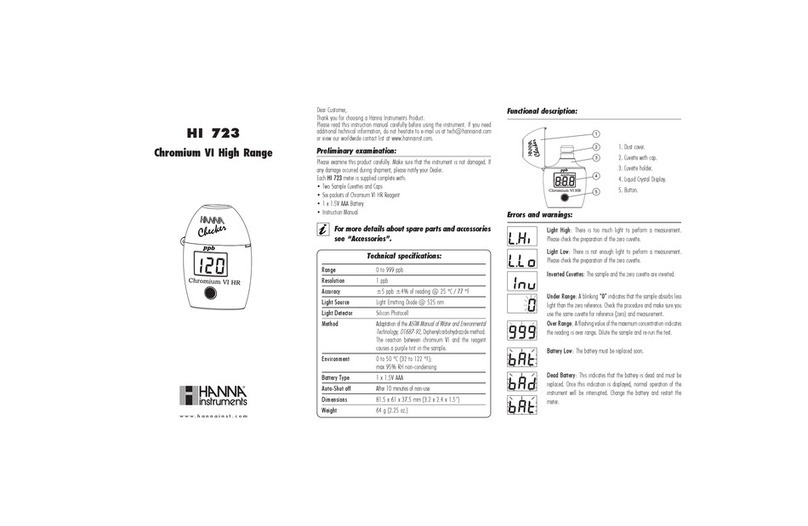
Hanna Instruments
Hanna Instruments Chromium VI quick start guide
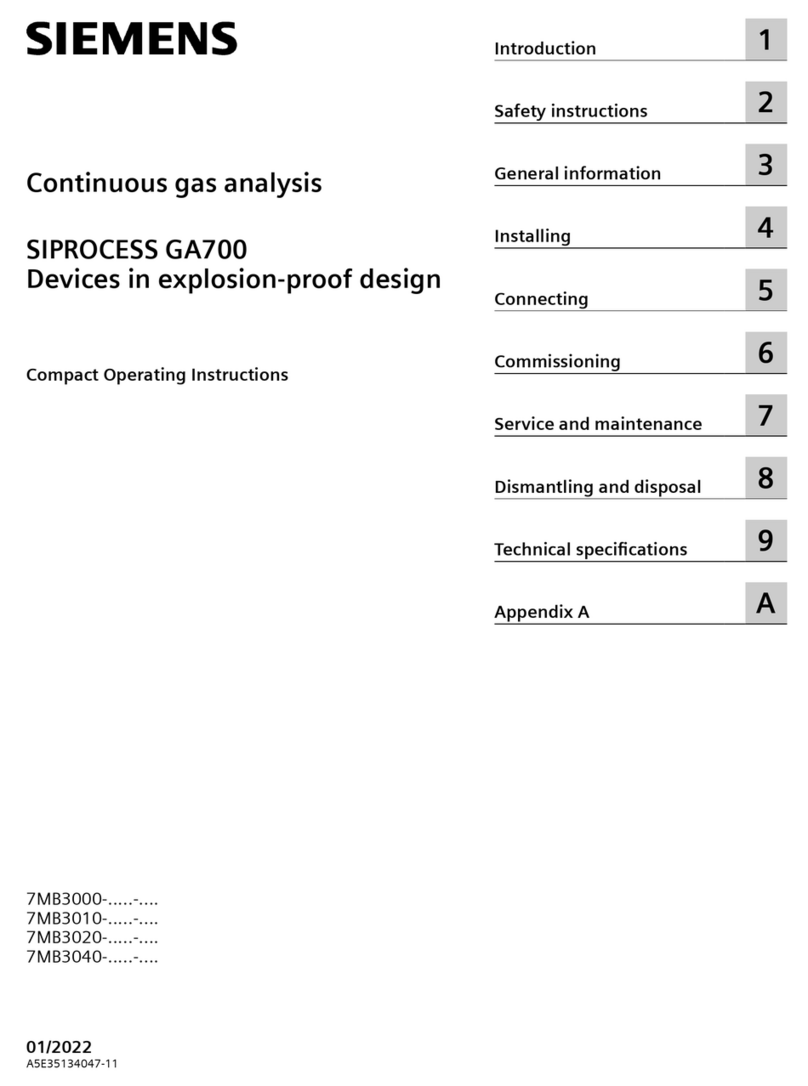
Siemens
Siemens SIPROCESS GA700 Compact operating instructions
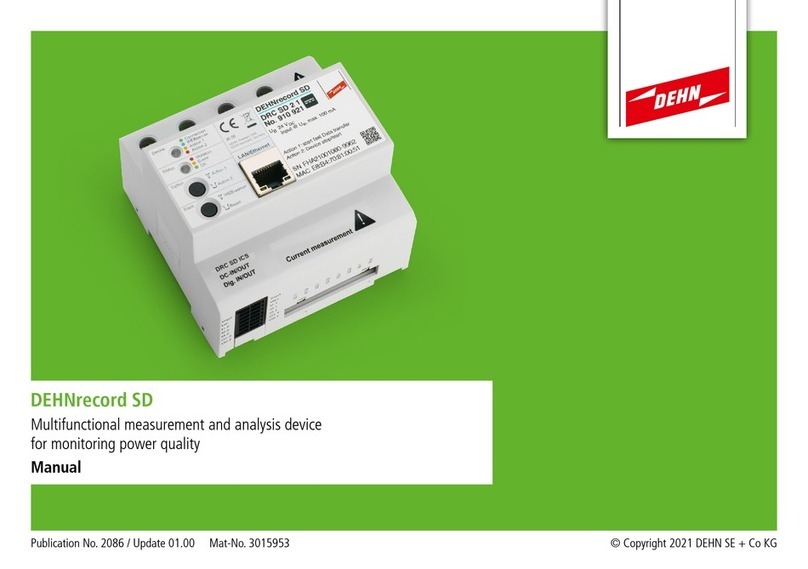
dehn
dehn DEHNrecord SD manual

Anritsu
Anritsu MS2690A Operation manual
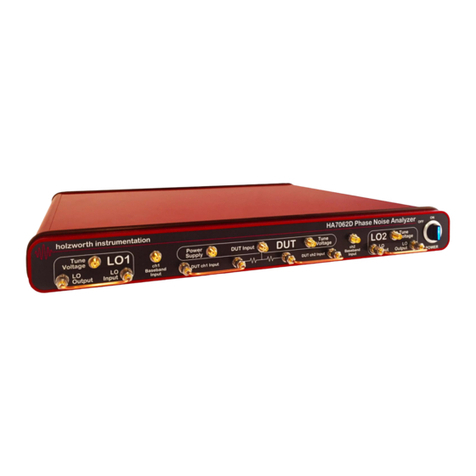
Holzworth Instrumentation
Holzworth Instrumentation HA7062D user manual
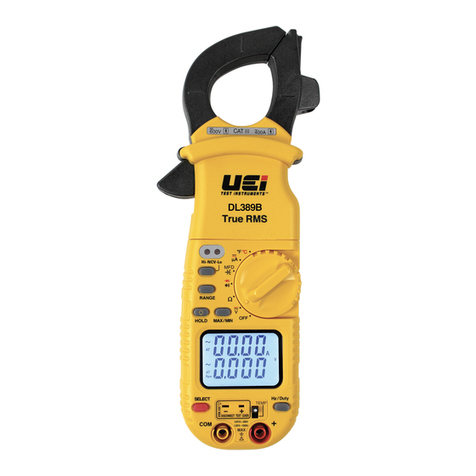
UEi
UEi DL389B instruction manual
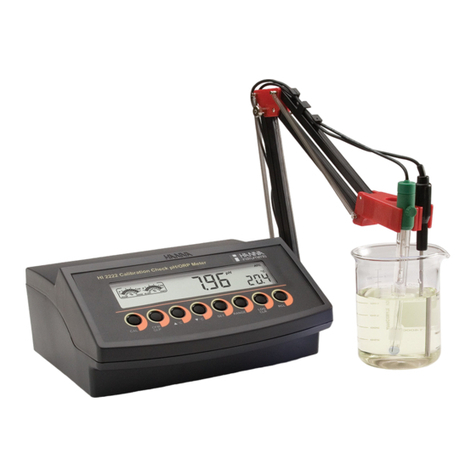
Hanna Instruments
Hanna Instruments HI 2222 instruction manual
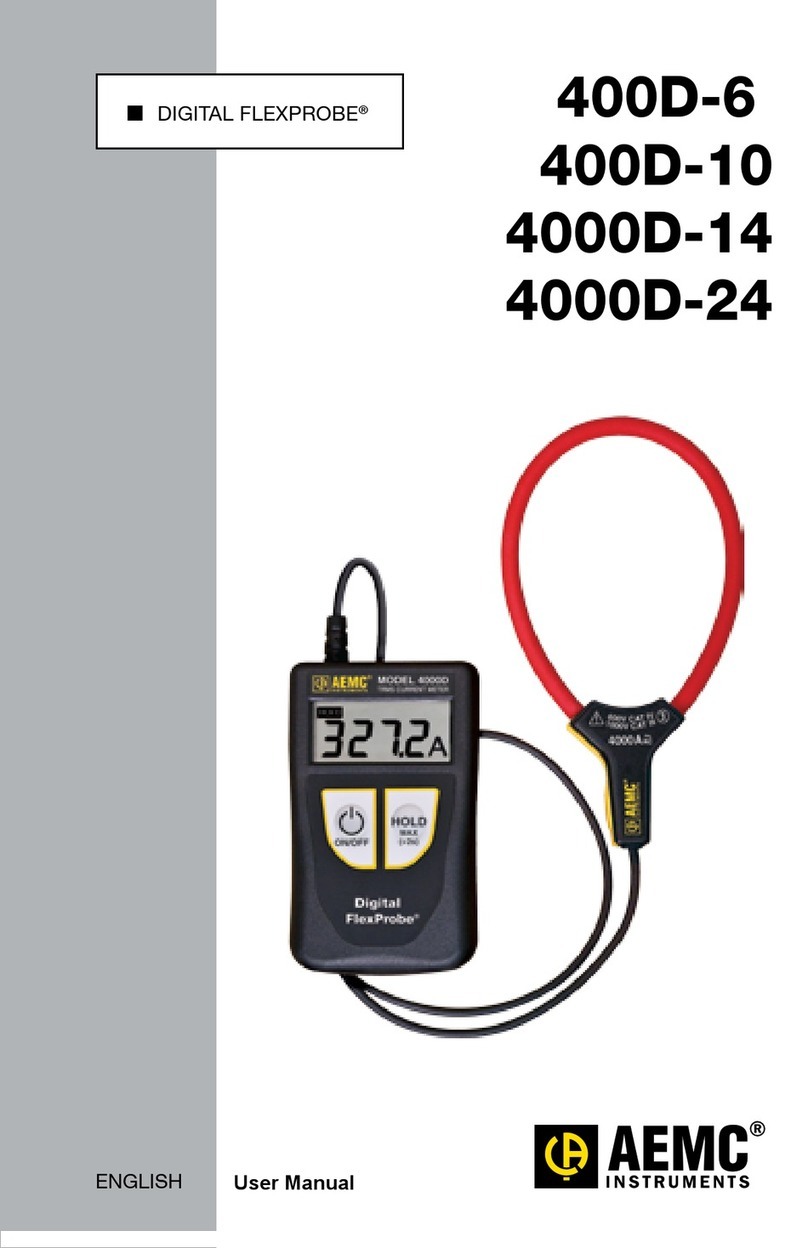
AEMC
AEMC 4000D-14 user manual
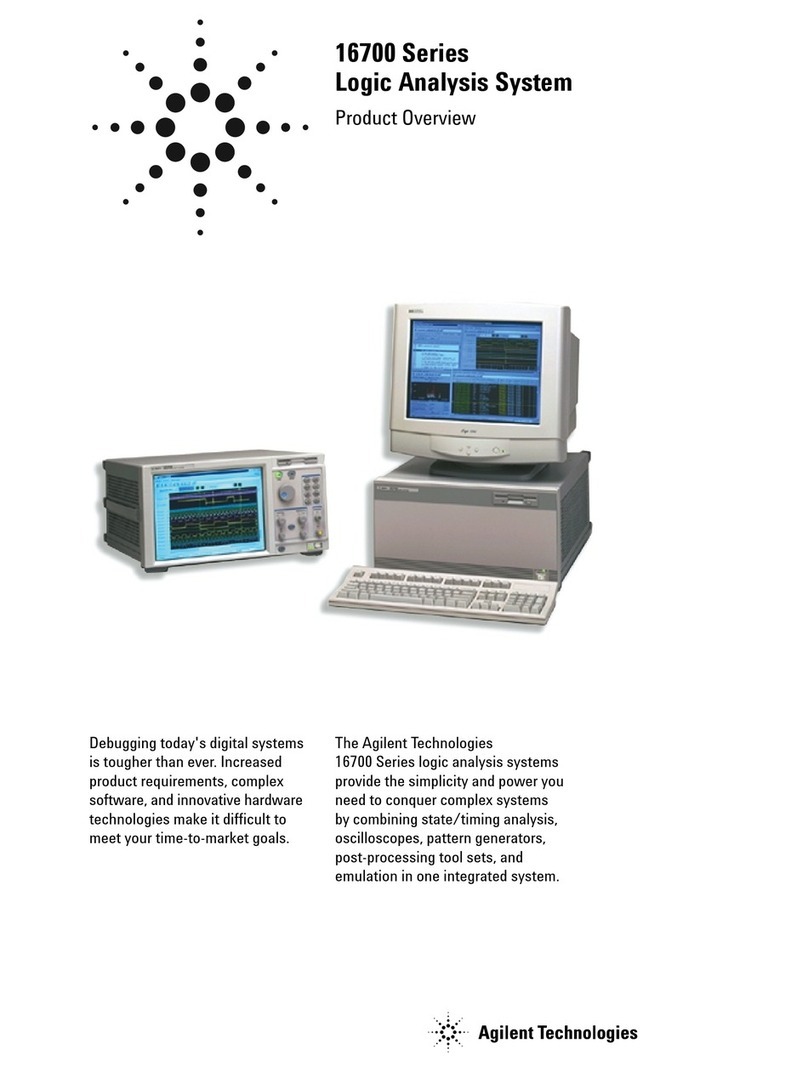
Agilent Technologies
Agilent Technologies 16700 SERIES LOGIC ANALYSIS SYSTEM 16700 Product overview

HP
HP 70900B series Service guide

Brooks Instrument
Brooks Instrument SLA5840 Installation and operation manual
